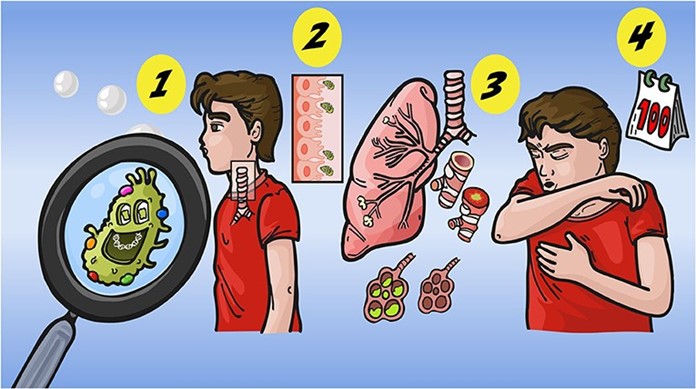A nurse is caring for a child who has pertussis. The child's parent asks the nurse what the common name for this disease is. The nurse should respond with which of the following common names?
Mumps
Whooping cough
Fifth disease
Chickenpox
The Correct Answer is B
Choice A reason: This choice is incorrect because mumps is not the common name for pertussis. Mumps is a viral infection that causes inflammation of the salivary glands, especially the parotid glands. It may cause symptoms such as fever, headache, and swelling of the cheeks or jaw. It can be prevented by vaccination with the measles-mumps-rubella (MMR) vaccine.
Choice B reason: This choice is correct because whooping cough is the common name for pertussis. Pertussis is a bacterial infection that causes severe coughing spells, which may be followed by a high-pitched whoop sound or vomiting. It may cause complications such as pneumonia, seizures, or brain damage, especially in infants and young children. It can be prevented by vaccination with the diphtheria-tetanus-pertussis (DTaP) vaccine.
Choice C reason: This choice is incorrect because the fifth disease is not the common name for pertussis. The fifth disease is a viral infection that causes a rash on the face, trunk, and limbs, which may resemble a slapped cheek appearance. It may cause mild symptoms such as fever, runny nose, or joint pain. It usually affects children and is self-limiting.
Choice D reason: This choice is incorrect because chickenpox is not the common name for pertussis. Chickenpox is a viral infection that causes an itchy rash with fluid-filled blisters all over the body. It may cause symptoms such as fever, headache, or loss of appetite. It can be prevented by vaccination with the varicella-zoster (VZV) vaccine.

Nursing Test Bank
Naxlex Comprehensive Predictor Exams
Related Questions
Correct Answer is B
Explanation
Choice A: This statement is correct, as the mother should notify the doctor if the child's temperature is not controlled with acetaminophen, which is an antipyretic and analgesic medication that can lower fever and relieve pain. A high fever can increase the child's metabolic rate and insulin requirements, which can lead to hyperglycemia or ketoacidosis.
Choice B: This statement is incorrect, as the mother should check the child's blood sugar more frequently than two times every day, especially when the child is sick. An upper respiratory infection can cause inflammation and stress hormones, which can increase the child's blood sugar levels and insulin needs. The mother should monitor the child's blood sugar at least four times a day or more often if indicated by symptoms or ketone testing.
Choice C: This statement is correct, as the mother should encourage the child to drink half a cup of water or sugar-free fluids every 30 minutes, which can prevent dehydration and flush out excess glucose and ketones from the body. Dehydration can worsen hyperglycemia and ketoacidosis, which are serious complications of diabetes.
Choice D: This statement is correct, as the mother should report a change in the child's breathing or any signs of confusion, which can indicate respiratory distress or cerebral edema. Respiratory distress can occur due to hypoxia or acidosis, which can impair oxygen delivery and carbon dioxide elimination. Cerebral edema can occur due to fluid shifts or electrolyte imbalances, which can cause increased intracranial pressure and neurological impairment.
Correct Answer is C
Explanation
Choice A: Shingles is a viral infection that causes a painful rash, usually on one side of the body. It is caused by the same virus that causes chickenpox. Shingles is not related to tinea pedis, which is a fungal infection.
Choice B: Valley fever is a fungal infection that affects the lungs and can cause flu-like symptoms, such as fever, cough, and chest pain. It is caused by inhaling spores from a fungus that grows in dry soil. Valley fever is not related to tinea pedis, which affects the skin of the feet.
Choice C: Athlete's foot is a common name for tinea pedis, which is a fungal infection that affects the skin between the toes and on the soles of the feet. It can cause itching, burning, scaling, and cracking of the skin. Athlete's foot is contagious and can be spread by direct contact or by sharing shoes, socks, or towels.
Choice D: Fever blister is another name for a cold sore, which is a small blister that forms on or near the lips. It is caused by a type of herpes virus that can be transmitted by kissing or sharing utensils. Fever blister is not related to tinea pedis, which is a fungal infection.
Whether you are a student looking to ace your exams or a practicing nurse seeking to enhance your expertise , our nursing education contents will empower you with the confidence and competence to make a difference in the lives of patients and become a respected leader in the healthcare field.
Visit Naxlex, invest in your future and unlock endless possibilities with our unparalleled nursing education contents today
Report Wrong Answer on the Current Question
Do you disagree with the answer? If yes, what is your expected answer? Explain.
Kindly be descriptive with the issue you are facing.
